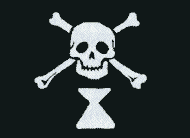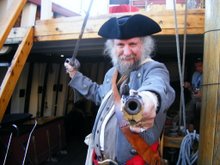Nothing says pirate event like standing on a sandy island under a palm tree, watching two tall ships firing cannons at each other on a warm night in December.
I was in Key West for the Fort Zachary Taylor Pirate Fest, part of the larger Pirates in Paradise festival.
The larger festival is purely "pirate" (or polyester pirate as some people call them). It included Captain Hook and a pirate Santa Clause. The part of it in the fort was focused much more on history although there were still some ren fair pirates.
The historical pirates had our own camp, officially the "careening camp". The idea was that we were camping on an island while our ship was being careened (this involved beaching the ship and scraping the growths off of the sides for extra speed). The festival continued into the fort with a couple of dozen vendors. These ranged from the same suttlers who set up at any historic event to a Utilikilt vendor (modern kilts).
The festival ran for four days. Each day had an attack on the fort. The first two days the pirates attacked unsuccessfully. On the third day they succeeded in capturing the fort. On the fourth day the British tried to recover the fort but failed.
The pirates were armed with small arms, mainly pistols and blunderbusses, and cannon. The British had more muskets and rifles and their own cannon. The pirates were aided by the tall ship, the Wolf which also fired on the fort.
There were three different two-masted ships that were part of the festival. At sunset each day they sailed past the camp, often firing on each other. There was also some firing from the walls at sunset most evenings.
Key West had a holiday parade on Saturday night and most of the pirates joined in that. I took a cab with a couple of others. We ran into a few more pirates near the start of the parade and decided to wait there. By the time the pirate unit went by we had around 20. Other pirates kept joining. I would guess that there were around 100 by the end of the parade.
On Sunday night the fort held a pig roast for the participants. The was accompanied by a "dead man's chest" auction to benefit the site and a show of some of the photographs that had been taken during the festival.
Wednesday, December 17, 2008
Tuesday, December 2, 2008
Shallops
A shallop (from the French chaloupe en fagot) was a small boat, larger than a ship's boat. The prow and stern were rounded. The stern was shaped like the bow except for the addition of a rudder and tiller. They could be disassembled into two or more pieces for easy transport. Both the Jamestown and Plymouth colonies had them. John Smith spent months on one mapping the Chesapeake. The one that the Pilgrims had was their chief means of transportation by water for some time. They were mainly coastal vessels. Larger ones might have a deck or half-deck. They were good craft for exploration since they were shallow-drafted and could be sailed or rowed.
These were not ideal pirate boats by any means but pirates tended to make due with whatever was at hand. Morgan probably had a shallop or two with him on some of his raids.
I've been looking at modern examples to study their rigging. They have the same type of sails as my Whitehall boat - a large sprit-rigged sail and a jib.
There are at least five modern shallops. The oldest was designed for Plimoth Plantation by William Baker who designed most of the 17th century reproductions built in the 1950s through the 1970s. There are no paintings or woodcuts that show shallops by name so he had to decide which type of boat to use. He went with a style that is common in Dutch paintings. This had the sprit-rigged sail and lee-boards rather than a keel.
The Pilgrim shallop was built to meet the Mayflower II when it arrived in America in 1957. Baker's plans called for it to be lapstrake (overlapped planks) but the builders refused, insisting that this was a sign of inferior workmanship. I've been on this shallop a couple of times, once for an afternoon sail and once for three days of filming a National Geographic video on John Smith's voyage.
The John Howland Society along with Plimoth Plantation built a larger shallop based on a description from William Bradford's History of Plimoth Plantation. There is an account here including the reasoning behind the design and a description of the launch.
Three other shallops were built for Jamestown's 400th anniversary. You can see them all here and here. (Note that one of these has a wineglass transom.) Here are pictures of one of them being built.
Here is a PDF document with a lot of information on shallops including naming the diffierent parts. Pirates who want to know more about ships should study this. This shallop was designed from the beginning to be broken down into two pieces. Note that each half can float on its own. The halves are kept together with special pieces from the keel and rails.
Here is a archaeological dig of an original late-17th century shallop.
There are numerous images of shallops on Google Image.
These were not ideal pirate boats by any means but pirates tended to make due with whatever was at hand. Morgan probably had a shallop or two with him on some of his raids.
I've been looking at modern examples to study their rigging. They have the same type of sails as my Whitehall boat - a large sprit-rigged sail and a jib.
There are at least five modern shallops. The oldest was designed for Plimoth Plantation by William Baker who designed most of the 17th century reproductions built in the 1950s through the 1970s. There are no paintings or woodcuts that show shallops by name so he had to decide which type of boat to use. He went with a style that is common in Dutch paintings. This had the sprit-rigged sail and lee-boards rather than a keel.
The Pilgrim shallop was built to meet the Mayflower II when it arrived in America in 1957. Baker's plans called for it to be lapstrake (overlapped planks) but the builders refused, insisting that this was a sign of inferior workmanship. I've been on this shallop a couple of times, once for an afternoon sail and once for three days of filming a National Geographic video on John Smith's voyage.
The John Howland Society along with Plimoth Plantation built a larger shallop based on a description from William Bradford's History of Plimoth Plantation. There is an account here including the reasoning behind the design and a description of the launch.
Three other shallops were built for Jamestown's 400th anniversary. You can see them all here and here. (Note that one of these has a wineglass transom.) Here are pictures of one of them being built.
Here is a PDF document with a lot of information on shallops including naming the diffierent parts. Pirates who want to know more about ships should study this. This shallop was designed from the beginning to be broken down into two pieces. Note that each half can float on its own. The halves are kept together with special pieces from the keel and rails.
Here is a archaeological dig of an original late-17th century shallop.
There are numerous images of shallops on Google Image.
Subscribe to:
Posts (Atom)

